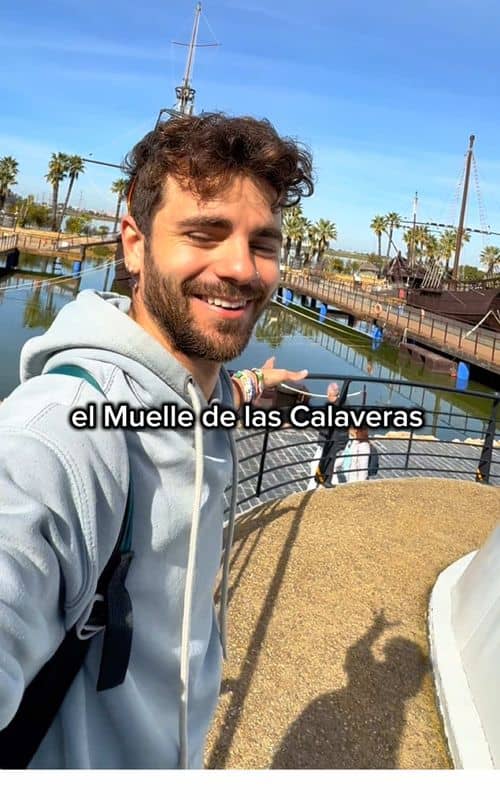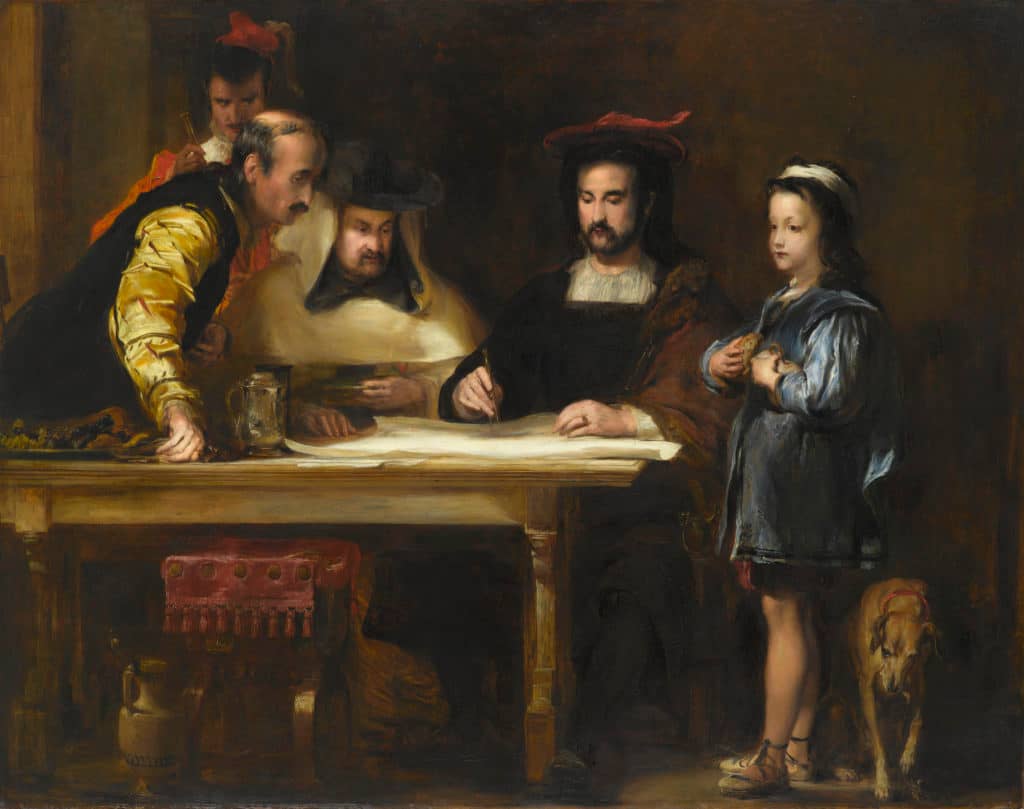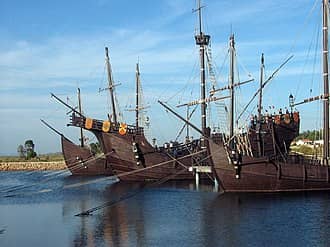
La Rábida Monastery
A 13th-century Franciscan hermitage where Columbus prayed before discovering America, now a museum with historical relics and beautiful gardens.

Highlights
Must-see attractions

Social
From TikTok & Reddit
Best Time
Fewer crowds, pleasant weather

La Rábida Monastery
Best Time
Fewer crowds, pleasant weather

Highlights
Must-see attractions
A 13th-century Franciscan hermitage where Columbus prayed before discovering America, now a museum with historical relics and beautiful gardens.
"A real gem of historical significance, like a treasure trove holding many artifacts from 1492."

Audio Guide is Key
Enhance your understanding of the historical significance with an audio guide, available in multiple languages. :iphone:
Explore the Gardens
Don't miss the beautiful gardens surrounding the monastery; they offer a peaceful escape. :seedling:

Highlights
Discover the most iconic attractions and experiences

Columbus's Prayer Site
Church
The very spot where Christopher Columbus sought divine guidance before his historic voyage.

Columbus Museum
Hermitage
Discover relics and exhibits detailing Columbus's preparations and the discovery of America.

Frescoes by Daniel Vazquez Díaz
Courtyard
Stunning pre-cubist frescoes depicting Columbus and his expedition adorn the courtyard walls.

Replica Caravels
Muelle de las Carabelas (nearby)
See life-sized replicas of La Niña, La Pinta, and La Santa María, the ships of Columbus's fleet.
Plans like a pro.
Thinks like you
Planning Your Visit
Historical Significance
Plan Your Visit
Best Times
Insider Tips
from TikTok, Instagram & Reddit
Audio Guide is Key
Enhance your understanding of the historical significance with an audio guide, available in multiple languages. :iphone:
Explore the Gardens
Don't miss the beautiful gardens surrounding the monastery; they offer a peaceful escape. :seedling:
Visit the Caravel Museum
Combine your visit with the nearby Muelle de las Carabelas for a complete historical experience. :ship:
Allow Ample Time
Set aside at least half a day to fully appreciate the monastery and its surroundings. :clock:
Tips
from all over the internet
Audio Guide is Key
Enhance your understanding of the historical significance with an audio guide, available in multiple languages. :iphone:
Explore the Gardens
Don't miss the beautiful gardens surrounding the monastery; they offer a peaceful escape. :seedling:
Visit the Caravel Museum
Combine your visit with the nearby Muelle de las Carabelas for a complete historical experience. :ship:
Allow Ample Time
Set aside at least half a day to fully appreciate the monastery and its surroundings. :clock:
What Travellers Say
Reviews Summary
Visitors consistently praise La Rábida Monastery for its profound historical significance, particularly its connection to Christopher Columbus's voyages. The beautiful gardens and the nearby replica caravels are also frequently highlighted as major attractions, offering a comprehensive historical experience.
"This place is wonderful. I visited here many times when I was a little girl, while living in Andalucía. This is a very special monastery. It's the point where Christopher Columbus left from Spain to discover the New World. When you walk out to the balcony, you can see replicas of La Niña, La Pinta, y La Santa María. The view from this wonderful balcony is really impressive and very beautiful.
This monastery is also unique in that it is also a museum of the time when Christopher Columbus was preparing to sail to the New World and sought the advice of the Franciscan monks here.
La Rábida is a real gem of the historical significance of this time. Like a treasure trove, it holds many artifacts of this time in 1492. It really is such a wonder to visit every single time.
I truly love it here. The area is really lovely. It is one of my top two favorite places in the entire world."
mar zald
"An interesting place to visit.
This Franciscan monastery is best known for the visit of Christopher Columbus in 1490 and his consultation with the Franciscan monks about the circumnavigation he was planning. Here he stands for two years. Currently, many relics from the discovery of America are exhibited here.
The monastery consists of an authentic-looking church and a statue of Our Lady of Miracles, in front of which Columbus prayed for hours before setting off with his crew for the New World, and a hermitage with a garden, which has been converted into a Columbus museum. There is an exhibit hall where the flags of each of the countries in the Americas are on display and a small sealed vessel containing soil from the New World. Surrounding the courtyard are frescoes in a pre-cubist style done by the Spanish artist Daniel Vazquez Díaz in 1930. The subject of these paintings is Columbus and his expedition.
Set aside at least half a day, as it is an interesting place, and around it there is a garden, a park, and nearby is the museum with Columbus's three caravels. Near to the monastery is José Celestino Mutis Botanical Park"
Sonya Miteva
"Historic place. The nature all around is mind blowing. Interesting for the ones who like the history of C.Columbus and discovery of the America
Sailor Imran"
Md Ashif Imran Yousuf
What People Like
What People Dislike
Frequently Asked Questions
🚇 🗺️ Getting There
La Rábida Monastery is located in Palos de la Frontera, Huelva, Spain. You can reach it by car, with parking available nearby. Public transport options might include local buses from Huelva city. Many visitors combine this with a trip to the Muelle de las Carabelas, which is a short distance away.
While direct public transport might be limited, local buses from Huelva city often serve the area. It's advisable to check current schedules. The proximity to the Muelle de las Carabelas also means you might find transport options that cover both sites.
Driving is a convenient option, offering flexibility. Alternatively, local buses can take you to Palos de la Frontera, from where you can reach the monastery. Taxis are also available.
Yes, the Muelle de las Carabelas (Caravel Museum) is a major nearby attraction, featuring replicas of Columbus's ships. The José Celestino Mutis Botanical Park is also in the vicinity.
The distance is manageable for a pleasant walk, especially if you enjoy scenic routes. It's a good way to experience the area between the two historical sites.
🎫 🎫 Tickets & Entry
Entry to the monastery itself is generally free, but there might be charges for specific museum exhibits or guided tours. It's always best to check the official website or inquire upon arrival for the most current information.
Opening hours can vary seasonally. Typically, the monastery is open during daylight hours, with specific times for the museum and gardens. It's recommended to verify the current operating hours before your visit.
The Columbus Museum, housed within the hermitage, may have a separate admission fee. Information regarding ticket prices and availability should be confirmed directly with the site.
Opening hours on public holidays can differ. Some sites may be closed or have reduced hours. It's advisable to check in advance if you plan to visit on a holiday.
Discounts may be available for students, seniors, or groups. Inquire at the ticket office or check the official website for any applicable concessions.
🎫 🧭 Onsite Experience
You can explore the historic church where Columbus prayed, visit the Columbus Museum with its relics, admire the frescoes in the courtyard, and wander through the serene gardens. The nearby Muelle de las Carabelas is also a must-see.
Yes, an audio guide is available and highly recommended to enhance your understanding of the monastery's rich history and significance. It's often available in multiple languages.
It's historically significant as the place where Christopher Columbus sought counsel from Franciscan monks before his 1492 voyage to the Americas. It holds many artifacts from that era.
Absolutely! The gardens are described as beautiful and offer a peaceful, lovely environment to explore. They are a highlight for many visitors.
The frescoes in the courtyard, created by Daniel Vazquez Díaz, depict scenes from Christopher Columbus's life and his expedition to the New World.
📸 📸 Photography
Photography rules can vary. Generally, photography for personal use is permitted in most outdoor areas and the museum, but flash photography might be restricted to protect artifacts. Always check for signage.
The courtyard with its frescoes, the serene gardens, and the exterior architecture offer excellent photographic opportunities. The view from the balcony overlooking the area is also picturesque.
Drone usage is typically restricted at historical and religious sites to preserve the atmosphere and for safety reasons. It's highly unlikely to be permitted without special authorization.
Yes, the museum exhibits, the church where he prayed, and the nearby replica caravels at Muelle de las Carabelas provide unique photo opportunities related to Columbus's voyages.
Many visitors capture the historical architecture, the serene gardens, and the artistic frescoes. The connection to Columbus's journey also inspires thematic photography.
For Different Travelers
Tailored advice for your travel style
👨👩👧 Families with Kids
To make the visit smoother, plan for at least half a day, as there's a lot to see. Pack snacks and drinks, especially if visiting during warmer months. The historical significance can be explained in simple terms, focusing on the bravery of the sailors and the excitement of discovery. The frescoes in the courtyard also offer a visual storytelling element that kids might appreciate.
📚 History Buffs
To truly immerse yourself, opt for the audio guide, which provides detailed historical narratives and context for the exhibits. Visiting the Muelle de las Carabelas is also highly recommended, as it offers a tangible representation of the ships that made history. Consider researching Columbus's life and the Franciscan order's role in exploration prior to your visit to maximize your appreciation of the site's profound historical significance.
🚶♀️ Solo Travelers
Take your time to absorb the atmosphere of the monastery and imagine Columbus's journey. The nearby Muelle de las Carabelas is also easily explored solo, allowing you to appreciate the scale of the caravels at your own pace. The historical narratives are rich, and the site’s significance is profound, making it a fulfilling experience for those seeking historical depth and personal reflection.
Deep Dives
In-depth insights and expert knowledge
The Historical Significance of La Rábida
The site itself is a testament to this era. Within its walls, visitors can find a museum filled with relics and artifacts from the Age of Discovery. These items offer tangible connections to Columbus's journey, including a small sealed vessel containing soil from the New World, a poignant reminder of the vastness of his achievement. The church, where Columbus is believed to have prayed before his departure, holds a special aura of reverence. Surrounding the central courtyard are striking frescoes by Spanish artist Daniel Vazquez Díaz, completed in 1930, which vividly depict Columbus and his epic expedition, adding an artistic layer to the historical narrative.
Beyond the monastery itself, the experience is often extended to include the nearby Muelle de las Carabelas (Caravel Museum). Here, life-sized replicas of the Niña, Pinta, and Santa María stand as imposing reminders of the vessels that carried Columbus and his crew across the Atlantic. This complementary site truly brings the scale and daring of the 1492 voyage to life, making a visit to La Rábida a comprehensive journey back in time.
Exploring the Monastery and its Surroundings
The gardens surrounding the monastery are frequently praised by visitors for their beauty and tranquility. They offer a peaceful respite and a lovely setting for a stroll, providing a stark contrast to the intense historical narratives within the museum. Many reviewers highlight the gardens as a particularly enjoyable aspect of their visit, adding to the overall serene atmosphere of the site.
Crucially, a visit to La Rábida is often paired with the Muelle de las Carabelas, a short distance away. This open-air museum features impressive, full-scale replicas of Columbus's three caravels: La Niña, La Pinta, and La Santa María. Walking aboard these ships offers a unique perspective on the challenges and scale of the 15th-century transatlantic voyages. The combination of the monastery's historical depth and the tangible presence of the caravels creates a powerful and immersive historical experience.






Social
from TikTok, Instagram & Reddit